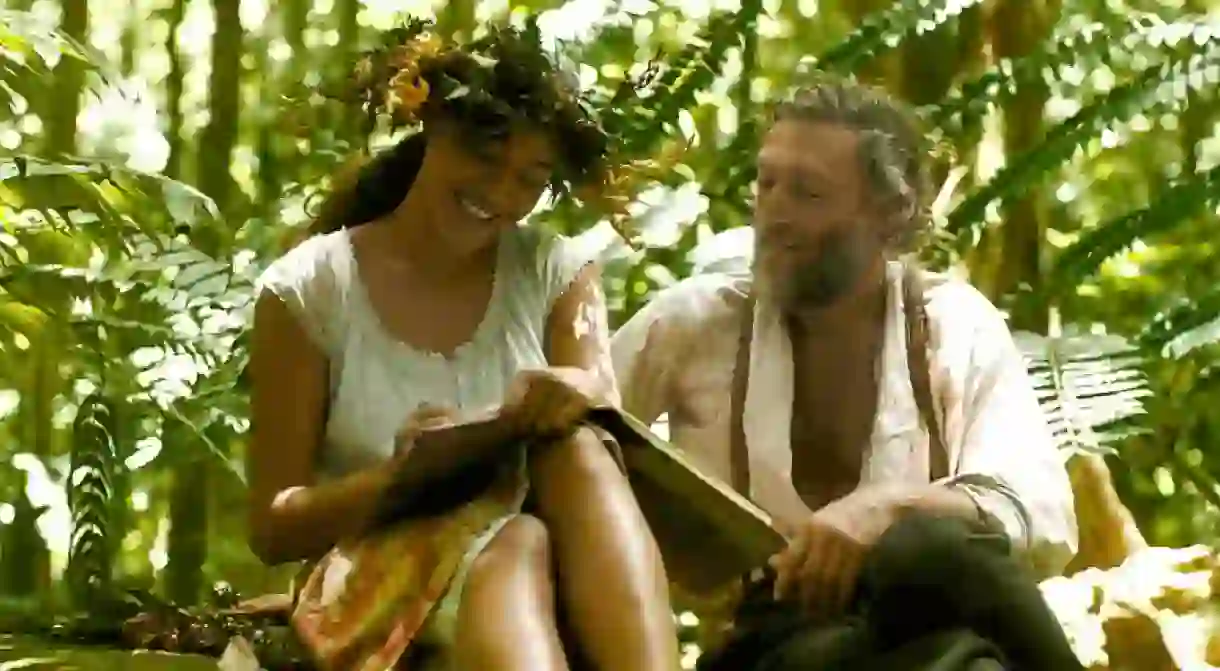The Paul Gauguin Biopic That Should Have Been More Troubling

Gauguin: Voyage to Tahiti gets across the painter’s passionate Primitivism, but avoids the unpalatable aspects of his first sojourn on the island.
Taken on its own terms, Edouard Deluc’s film Gauguin: Voyage to Tahiti is a moderately satisfying biopic about the artist Paul Gauguin’s first stay in Tahiti from 1891-1893. Whatever satisfactions it affords, however, are compromised by the movie’s evasions of the supposed truth.
Having abandoned his Danish wife and five children in Paris, Gauguin (Vincent Cassel) is living in poverty in Papeete—the capital of French Polynesia—when he collapses while returning to his hut with supplies. His white doctor, Henri Vallin (Malik Zidi), tells Gauguin, who’s about 43, that he has had a heart attack and that his diabetes has advanced. Gauguin’s heart problems were probably attributable to cardiovascular syphilis, but the film makes no mention of this stigmatized disease.

To get his painting fix, Gauguin abandons his hospital bed and heads off to the Taravao Plateau. Unable to spear fish or shoot them with his rifle, he runs short of rations and stumbles, hungry and exhausted, into a indigenous camp at night. There, he gets his first look at the beautiful Tehura (Tuheï Adams) dancing sensuously in the firelight.
A day or two later, Tehura’s mother or guardian arranges her marriage to Gauguin during a meal. Tehura (whose real name was Teha’amana) is 17 or 18 in the film, but Gauguin said she was 13 when they married. His two later Polynesian brides were 13 and 14 (other accounts say they both were 14), and it is believed that he infected all three with syphilis.
It was not uncommon for white men to take child brides during the colonization of the Pacific Islands in the 19th century. By Gauguin’s own account, he and Tehura had a loving relationship “filled to the full with happiness.” Partially based on his travel journal Noa Noa (1901), the movie shows the couple lying in bed at night and talking about the stars.
Whatever intimacy they enjoyed and however sexually and emotionally mature Tehura was—by August 1892 she was pregnant, according to a Gauguin letter—does not, of course, mitigate the fact that Gauguin was a pedophile. Assessing his undoubted genius as a Modernist-Primitivist artist who freed Post-Impressionist painting from the civilized ‘norm’ has been complicated by his reputation and by his rejection of all moralities.

Gauguin: Voyage to Tahiti is a cautionary tale about the start and end of a love affair that shows how hubris catches up with a middle-aged colonialist who weds a young indigenous girl. It also shows how the couple’s transient bond inspired some of Gauguin’s greatest works—Ia Orana Maria (Hail Mary, 1891), Manao tupapau (Spirit of the Dead Watching, 1893-1894), Merahi metua no Tehamana (Tehamana Has Many Parents, 1893)—and how the relative paradise of Tahiti liberated him as an artist.
It is, however, only a paradise in comparison with the Paris of the bourgeoisie and the demi-monde because, by the early 1890s, Christianity and Western imperialism had eroded Tahiti’s pre-colonial Edenic purity, not that that stopped Gauguin from re-creating it in his work. The sight of a Tahitian prostitute being manhandled in a seafront bar is one sign of colonial rottenness.
The victim of love in Gauguin: Voyage to Tahiti is not the vulnerable island girl but the opportunistic ageing white man. In lieu of Gauguin’s predatoriness, Deluc foists on him the sin of sexual possessiveness—probably suggested by Gauguin’s questioning of Tehura’s fidelity in Noa Noa.
At one point, Tehura slips into a wood with a handsome young local admirer while Gauguin is preoccupied with his work. Later, he has reason to suspect that she has betrayed him with his former helper, Jotépha (Pua-Taï Hikutini). What makes this doubly worse for Gauguin is that Jotépha, who has learned to carve by watching Gauguin, is much better at selling wooden statues than is the permanently impoverished Frenchman.
Though Gauguin’s island idyll begins to crumble, the island itself—at least the uninhabited parts—maintains its tourist-brochure beauty. Deluc and his cinematographer Pierre Cottereau, who shot Deluc’s Welcome to Argentina (2012), punctuate the film with vistas of turquoise seascapes, verdant landscapes crowned by shadowy mountains, and rock faces split by foaming waterfalls.
Deluc and Cottereau chose not to accent the feverish sensuality of the Polynesian women to whom Gauguin was in thrall. There is one shot of Gauguin and Tehura having sex and another that makes Tehura look carnal from Gauguin’s perspective—and what she is lusting after at the time is a white dress to go to church in. Watching Gauguin innocently romping on a beach with little children further limits the idea of him as a celebrator of the noble savage. In this telling, he is an almost respectable wild man.
Gauguin: Voyage to Tahiti opens in the US on July 11.












